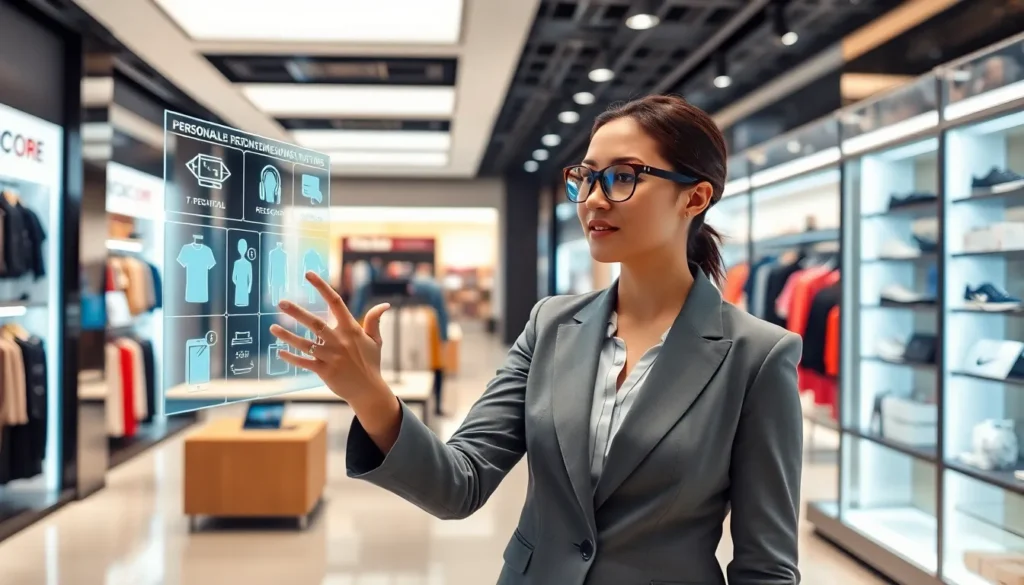Imagine walking through your favorite store, but instead of just browsing racks of clothes or electronics, a friendly hologram pops up to give you personalized recommendations. Welcome to the world of augmented reality shopping, where the old way of buying things gets a high-tech facelift. It’s not just futuristic fluff: it’s a game changer for retail and can make shopping a whole lot more fun (and less stressful). Let’s jump into how augmented reality (AR) is sprucing up the shopping experience.
Table of Contents
ToggleWhat Is Augmented Reality Shopping?

Augmented reality shopping blends digital elements with the physical shopping experience. It enhances real-world environments by adding computer-generated images, sounds, and even interactions. Think of it like a magic window, one that allows you to view products in your own space before making a purchase.
With AR, consumers can visualize how items look or fit in their homes. For instance, furniture stores are now using AR technology to let customers see how a sofa would look in their living room without needing to lug the furniture home first. It’s the kind of tech that makes online shopping feel more tangible.
In essence, AR shopping goes beyond just looking at pictures on a screen. It engages customers, offering immersive visuals that stimulate the senses while shopping.
The Evolution of Shopping: From Physical to Digital
Shopping hasn’t remained static, it has evolved dramatically. Remember when shopping meant hopping in your car and browsing stores? Now, it’s just as likely to involve scrolling through an app on a smartphone.
Initially, retail was all about in-store experiences, allowing customers to touch, feel, and try products. Then came the digital storefronts, revolutionizing convenience and accessibility. But this shift led to a disconnect: online shopping often feels impersonal, lacking the tactile engagement of traditional retail. The introduction of augmented reality takes us a step further, merging the convenience of online shopping with the interaction of in-store browsing.
As technology advances, consumers crave experiences that elevate everyday tasks. AR meets this demand, giving shoppers a way to interact directly with the products they are considering. And it’s not just a cool gimmick: it’s reshaping how people relate to brands.
Benefits of Augmented Reality in Retail
The benefits of augmented reality shopping stretch from enhanced customer satisfaction to improved business operations. First and foremost, AR provides a rich, engaging experience that captures consumer attention. When customers can visualize products in their environments, it reduces uncertainty and encourages purchases.
Also, AR can lower return rates. If shoppers can see how a dress fits on them or how a lamp looks in their home, they are less likely to face buyer’s remorse. This visual assistance boosts confidence in purchase decisions.
On the business front, AR also offers valuable insights. Retailers can track how consumers interact with their AR features, helping them refine marketing strategies and product placements based on real-time data.
Challenges and Limitations of Augmented Reality Shopping
While augmented reality presents many opportunities, it also faces significant challenges. One major hurdle is technology accessibility. Not everyone has the latest devices capable of supporting AR applications, limiting the reach of this shopping method. Also, developing AR expertise and applications can be costly for retailers, particularly for small businesses.
Another limitation is the user experience. If AR applications are too complicated or glitchy, consumers may have a negative impression of a brand. Ensuring smooth, engaging interactions is crucial, and any hiccup can lead to frustration.
Finally, privacy concerns cannot be overlooked. With AR apps potentially tracking user data to enhance shopping experiences, consumers are growing more cautious about sharing their information.
How Businesses Are Implementing Augmented Reality
Businesses worldwide are jumping on the AR bandwagon in innovative ways. Retail giants like IKEA have created apps that let users see how furniture fits in their space before buying. Cosmetic brands like L’Oréal offer AR features that allow users to virtually try on makeup. It’s as though a personal stylist is just a tap away.
Beyond consumer-facing apps, companies are also using AR for employee training and enhancing their logistics processes. For instance, AR can help warehouse workers locate items more efficiently by overlaying directions onto their real-world environment.
As companies adopt AR technology, they not only enhance the shopping experience but also streamline their operations, leading to greater efficiency and customer satisfaction.
Future Trends in Augmented Reality Shopping
What’s next for augmented reality shopping? The future looks exciting. As technology advances, expect to see even more seamless interactions. Imagine a shopping experience where you walk into a store and your smartphone automatically senses the products you’re interested in, presenting tailored options through AR.
Personalization will be crucial. As machine learning integrates with AR, shopping experiences will be refined based on individual preferences and previous purchases. Brands could use AR to narrate their stories, enhancing customer loyalty.
Also, virtual reality could integrate with AR systems, pushing the boundaries even further. Shoppers might find themselves visiting entire virtual showrooms, where they can interact with products in immersive environments.








